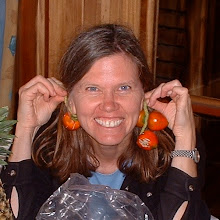
Did you know that the cashew nut we eat grows on the outside of a fruit? Every nut represents a fruit, perhaps explaining what cashews are so expensive. Native to Brazil, Ticos and other Spanish speakers call the fruit and nut marañón. People make a juice of the fruit and it's one fruit I just don't like. It smells bad to me. I'll stick to eating the delicious nuts.
The following photo shows two fruits: the red manzana de agua or water apple and mamón. Water apples, originally from the Malay peninsula and nearby areas, are quite bland and juicy. I guess they would be really good to quench a thirst on a very hot day. Not a frequent need in Monteverde so I don't eat them often. Mamón, a South American native, has a crisp shell around a large seed. In between the seed and the shell is a small layer of tart flesh. It's fun to peel the shell off with your fingernail and pop the insides in your mouth so you can gnaw the fruit off the seed. The fruit doesn't come off the seed easily so it's a good way to pass some time.
Here's another picture of water apples, a grenadilla and some green jocotes. A fruit from the cashew family originally from Central America, jocotes are now also cultivated in Asia. You eat jocotes whole, skin and all. Perhaps I would like them better if Costa Ricans let them ripen but here they are sold while still green so they are tart. I think maybe people sprinkle salt on the them, the way they do with unripe mangoes.
Grenadilla is a fruit related to passion fruit. The outside has a crisp, papery layer. Inside the many small seeds are each inside a small packet of juicy fruit. I scoop the insides into a blender and run at top speed briefly. Next I use a sieve to remove the seed particles. The seeds are edible so a few bits of seeds getting through isn't a problem. Then I make a smoothy with some yogurt, sugar, and ice. It's very aromatic and quite similar to passion fruit.








